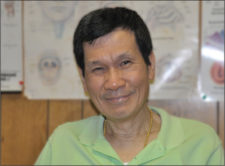Thai Doctor Served Where Many U.S. Physicians Don’t: In Rural Kentucky
Date: April 22, 2017
Dr. Manosh Vongvises, a retired ear, nose, and throat specialist, has seen the number of medical professionals in Pikeville, Kentucky, multiply in the last 30 years — and many are immigrants like him. According to a report by New American Economy, 21.6 percent of the doctors in Kentucky were educated abroad, and many serve in rural and underserved areas where American patients would otherwise lack medical care. “Foreign-born doctors are given the opportunity to help the underserved area of Eastern Kentucky,” Vongvises says. “A lot of foreign-born doctors are top-notch in their home countries, highly trained, and motivated to succeed in this country. They provide high quality care for patients.”

Yet there still aren’t enough doctors to meet the population’s need. As of 2013, several of Kentucky’s 120 counties still didn’t have a single primary care physician and more than a dozen counties had only one, landing the state 32nd nationally in ratio of physicians to population. University of Kentucky researchers said Kentucky would need 1,655 doctors to put it on a par with national availability. Meanwhile, the shortfall is only expected to worsen over the next decade, as more physicians retire. Without immigrants to fill the gap, the lack of doctors to treat Kentuckians would be even more pronounced than it is now. “With no foreign-born physicians in the area, the quality of medical care in the region would significantly decrease,” says Vongvises.
Skilled medical workers bring value to our communities and we need to make it easier for them to come here and work.
Vongvises grew up in Thailand and dreamed of completing his post-graduate training in the United States. After graduating from medical school in Thailand in 1972, he made good on this ambition, completing an internship at Washington Hospital Center in Washington, D.C.; a general surgery residency at Christ Hospital in Oak Lawn, Illinois; and a three-year otolaryngology (ENT) residency back at Washington Hospital Center.
Physicians with a specialty, such as Vongvises, are even less likely to practice in rural areas than general physicians, making doctors like him all that much more critical for the millions of Americans who don’t live in cities. While urban areas have an average of 263 medical specialists per 100,000 people, rural areas average only 30.
Vongvises came to Kentucky at the recommendation of a pediatrician friend in Pikeville. It was a dramatic change from life in Washington, D.C., where he’d been living. Pikeville, a rural community of fewer than 7,000 people, is located two hours from Charleston, West Virginia, and three hours from Lexington, Kentucky. More than 20 percent of the population lives below the poverty line. Though Vongvises was very much an outsider, he says the community welcomed him. “The people in Eastern Kentucky were not like those in the cities. They were very friendly to me,” he says. “When I arrived, everybody knew everybody, but even though they knew I was not American, they were very nice to me.” He ended up staying for 37 years and raising his three children in the town. He became a United States citizen in 2002 and finally retired from private practice in 2015.
Because he had lived and worked in the United States for so long, the citizenship process was quite straightforward. However, Vongvises realizes it is not as easy for every immigrant. He says that the country “needs immigrants with skills and education,” especially trained physicians. “The United States has provided excellent educational and career opportunities,” he says. “Skilled medical workers bring value to our communities and we need to make it easier for them to come here and work.”
